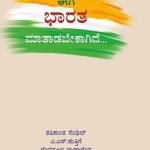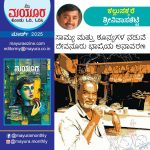Mythology meets history-N. MANU CHAKRAVARTHY
[Prof. Manu Chakraborty’s Review About Kusumbale in ‘The Hindu” newspaper on 12 June 2009. ಕುಸುಮಬಾಲೆ ಕುರಿತು 12 ಜೂನ್ 2009ರ ‘ದಿ ಹಿಂದೂ’ ಪತ್ರಿಕೆಯಲ್ಲಿ ಪ್ರೊ.ಮನು ಚಕ್ರವರ್ತಿ ಅವರು ಬರೆದ ವಿಮರ್ಶೆ.]
[Kusumabale by Devanooru Mahadeva, Abhinava Prakashana, Rs. 60]
Kusumabale is as much the life of a community as it is a revelation of the plight of women in a feudal, patriarchal order.
“Kusumabale” was first published more than two decades ago and the reception to it, then, signified many things that one needs to place in perspective at this juncture.
Within the Dalit world the responses were diverse. Some hailed it as a modern epic, a classic, while others, predominantly the activists, dismissed it as a luxurious indulgence, irrelevant to the conflicts and tensions of contemporary Dalit life. These responses symbolised the split within the Dalit Movement, a phenomenon that has developed along sharper lines of late. The contradictory attitudes and responses towards globalisation, tradition, modernity and nationalism shape these divergent responses to the text and there is a great need to understand “Kusumabale” in relation to all these.
In that sense “Kusumabale” represents the many dimensions of the Dalit consciousness. This is not to suggest, even by implication, that one should read the work only by relating it to Dalit experiences. While such reductionism would be wrong, at the same time, granting a certain kind of universality to the text should not mean erasing its rich and diverse socio-cultural location. The text is indeed rooted in a very specific socio-cultural area, and the entire landscape that emerges from it compels the reader to sharply particularise the text and its experiences. It would be a blunder to erase idioms and metaphors of the text. Similarly the existential experiences of individuals that shape their imagination, their linguistic registers that the text consciously works out must be reckoned with universality, which, if not properly qualified, is a vague and amorphous term. “Kusumabale” is remarkable for it does not seek a universal dimension through meaningless abstractions.
The responses to the text from the Kannada literary world too was mixed. Some, who did not wish to make an effort to comprehend the rather unfamiliar and strange “language” of the text, dismissed it and argued quite emphatically that it “had to be rewritten in proper Kannada”. But there were a few who instinctively accepted “Kusumabale” as a great lyrical text and admired its complex textures.
This edition of Devanooru Mahadeva’s “Kusumabale” (recast/restructured in the literal sense by L. Basavaraju) is a product of the deep mythopoeic vision of Mahadeva. However, Mahadeva’s profound mythical imagination is grounded in the multiple realities of the community he writes about and, hence, attains a strong historical dimension. The great integration of myth and history that Mahadeva achieves is the most outstanding feature of “Kusumabale”.
“Kusumabale” is about the life of a community narrated in an organic manner. But a careful reading reveals it is crucially about the sad plight of women in a feudal, patriarchal order. The stories of Akka Maadevamma, Tooramma, Kempi carry resonances/echoes of the epics and historical figures like Akka Mahadevi. (For instance, the manner in which Akka Maadevamma is treated, takes one back to Dushyaasana’s abuse of Draupadi). Like Mahashwetha Devi in “Dopdi” and “Stanadayini”, Mahadeva is subverting archetypal patterns. One must be conscious of how Mahadeva does this differently in “Odalaala”. The text questions notions of justice, crime, punishment of feudal institutions (the episode of Gaara Sidda maava caught stealing tender coconuts portrays this vividly).
The stories of the Dalit movement, the entry of various ideological positions (through the socialist and Marxist activists) into a realm that appears to be suspended in space and time constitute the tremendous dynamics of the text and the community it portrays. The meditative manner in which Mahadeva builds his narrative is not just a quality of the text, but, more importantly, reveals the strength and maturity of Dalit imagination and creativity, which is not just about rage, fury, oppression and cruelty. In great Dalit creativity one also comes face to face with rich cultural metaphors and philosophical attitudes, reminding one of how all that is drawn from Buddhism and other similar traditions. The conflicting responses to “Kusumabale” only uphold its complexity.







